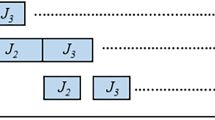Abstract
Online scheduling with a buffer is a semi-online problem which is strongly related to the basic online scheduling problem. Jobs arrive one by one and are to be assigned to parallel machines. A buffer of a fixed capacity K is available for storing at most K input jobs. An arriving job must be either assigned to a machine immediately upon arrival, or it can be stored in the buffer for unlimited time. A stored job which is removed from the buffer (possibly, in order to allocate a space in the buffer for a new job) must be assigned immediately as well. We study the case of two uniformly related machines of speed ratio s≥1, with the goal of makespan minimization.
Two natural questions can be asked. The first question is whether this model is different from standard online scheduling, that is, is any size of buffer K>0 already helpful to the algorithm, compared to the case K=0. The second question is whether there exists a constant K, so that a larger buffer is no longer beneficial to an algorithm, that is, increasing the size of the buffer above this threshold would not change the best competitive ratio further. Previous work (Kellerer et al., Oper. Res. Lett. 21, 235–242, 1997; Zhang, Inf. Process. Lett. 61, 145–148, 1997; Englert et al., Proc. 48th Symp. Foundations of Computer Science (FOCS), 2008) shows that in the case s=1, already K=1 allows to design a \(\frac{4}{3}\) -competitive algorithm, which is best possible for any K≥1, whereas the best possible ratio for K=0 is \(\frac{3}{2}\) . Similar results have been show for multiple identical machines (Englert et al., Proc. 48th Symp. Foundations of Computer Science (FOCS), 2008).
We answer both questions affirmatively, and show that a buffer of size K=2 is sufficient to achieve the a competitive ratio which matches the lower bound for K→∞ for any s>1. In fact, we show that a buffer of size K=1 can evidently be exploited by the algorithm for any s>1, but for a range of values of s, it is still weaker than a buffer of size 2. On the other hand, in the case s≥2, a buffer of size K=1 already allows to achieve optimal bounds.
Similar content being viewed by others
References
Albers S (1999) Better bounds for online scheduling. SIAM J Comput 29
Angelelli E, Nagy A, Speranza MG, Tuza Z (2004) The on-line multiprocessor scheduling problem with known sum of the tasks. J Sched 7(6):421–428
Angelelli E, Speranza MG, Tuza Zs (2008) Semi-online scheduling on two uniform processors. Theor Comput Sci 393(1–3):211–219
Azar Y, Regev O (2001) Online bin stretching. Theor Comput Sci 268:17–41
Englert M, Özmen D, Westermann M (2008) The power of reordering for online minimum makespan scheduling. In: Proc 48th symp foundations of computer science (FOCS), 2008, pp 603–612
Epstein L (2003) Bin stretching revisted. Acta Inf 39(2):97–117
Epstein L, Favrholdt LM (2005) Optimal non-preemptive semi-online scheduling on two related machines. J Algorithms 57(1):49–73
Epstein L, Ye D (2007) Semi-online scheduling with “end of sequence” information. J Comb Optim 14(1):45–61
Epstein L, Noga J, Seiden SS, Sgall J, Woeginger GJ (2001) Randomized online scheduling on two uniform machines. J Sched 4(2):71–92
Faigle U, Kern W, Turan G (1989) On the performance of online algorithms for partition problems. Acta Cybern 9:107–119
Gormley T, Reingold N, Torng E, Westbrook J (2000) Generating adversaries for request-answer games. In: Proceedings of the eleventh annual ACM-SIAM symposium on discrete algorithms (SODA), pp 564–565
Graham RL (1966) Bounds for certain multiprocessing anomalies. Bell Syst Tech J 45:1563–1581
Graham RL (1969) Bounds on multiprocessing timing anomalies. SIAM J Appl Math 17:416–429
He Y, Zhang G (1999) Semi on-line scheduling on two identical machines. Computing 62(3):179–187
Kellerer H, Kotov V, Speranza MG, Tuza Zs (1997) Semi online algorithms for the partition problem. Oper Res Lett 21:235–242
Li S, Zhou Y, Sun G, Chen G (2007) Study on parallel machine scheduling problem with buffer. In: Proc of the 2nd international multisymposium on computer and computational sciences (IMSCCS2007), pp 278–281
Seiden S, Sgall J, Woeginger G (2000) Semi-online scheduling with decreasing job sizes. Oper Res Lett 27(5):215–221
Sgall J (1998) On-line scheduling. In: Fiat A, Woeginger G (eds) Online algorithms—the state of the art. Springer, Berlin, pp 196–231. Chap 9
Zhang G (1997) A simple semi on-line algorithm for P2//C max with a buffer. Inf Process Lett 61:145–148
Zhang G, Ye D (2002) A note on on-line scheduling with partial information. Comput Math Appl 44(3–4):539–543
Author information
Authors and Affiliations
Corresponding author
Rights and permissions
About this article
Cite this article
Dósa, G., Epstein, L. Online scheduling with a buffer on related machines. J Comb Optim 20, 161–179 (2010). https://doi.org/10.1007/s10878-008-9200-y
Published:
Issue Date:
DOI: https://doi.org/10.1007/s10878-008-9200-y




